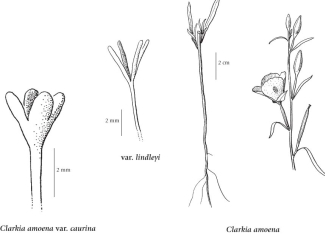farewell-to-spring (farewell to spring; godetia)
Onagraceae (Evening Primrose family)
Introduction to Vascular Plants
SUBTAXA PRESENT IN BC
Species Information
General:
Annual herb from a stout or slender taproot; stems spreading to erect, 10-100 cm tall, simple to freely branched, minutely hairy.
Leaves:
Alternate, linear to narrowly lanceolate, 2-7 cm long, mostly 2-6 mm wide; unstalked or stalks less than 3 mm long.
Flowers:
Inflorescence dense, axis straight when in bud, buds usually erect; hypanthium 2-10 mm long; corollas bowl-shaped, tending to close at night; petals pink to rose-purple, red-spotted or -marked near centre, egg- to fan-shaped, not clawed, 1-4 cm long; sepals usually joined and turned to one side, sometimes partially free; stamens 8, anthers glabrous or slightly hairy, all alike; stigmas 1-6 mm long, linear to oval, yellow; styles usually exceeding stamens.
Fruits:
Capsules, linear to somewhat club-shaped, (1) 1.5-4.5 cm long, straight to curved, beakless or with a beak several mm long, 4-grooved when young, later cylindric and 8-ribbed.
Notes:
Two sympatric varieties occur in BC:
1. Stigmatic lobes oval, usually not over 2 mm long; petals usually less than 2 cm long................ var. caurina (Abrams) C.L. Hitchc.
1. Stigmatic lobes linear, usually over 2 mm long; petals usually greater than 2 cm long............... var. lindleyi (Dougl.) C.L. Hitchc.
Illustration

If more than one illustration is available for a species (e.g., separate illustrations were provided for two subspecies) then links to the separate images will be provided below. Note that individual subspecies or varietal illustrations are not always available.
Illustration Source: The Illustrated Flora of British Columbia
Ecology
The table below shows the species-specific information calculated from
original data (BEC database) provided by the BC Ministry of Forests and Range.
(Updated August, 2013)
| Site Information |
Value / Class |
||
|
Avg |
Min |
Max |
|
| Elevation
(metres) |
|||
| Slope
Gradient (%) |
54 | 15 | 210 |
|
Aspect (degrees) |
177 | 90 | 280 |
| Soil
Moisture Regime (SMR) [0 - very xeric; 4 - mesic; 8 - hydric] |
1 | 1 | 2 |
| Modal
Nutrient Regime
Class |
|||
| #
of field plots species was recorded in: |
24 | ||
| Modal
BEC Zone Class |
|||
|
All BEC Zones (# of stations/zone) species was recorded in |
|||
|
Source:
Klinkenberg 2013
|
|||
Habitat and Range
Dry grassy areas in the lowland zone; infrequent on S Vancouver Island and the adjacent Gulf Islands; S to CA.Taxonomic Keys
1. Petals not narrowing to a claw at the base; flowers regular, closing at night.
2. Sepals usually joined and turned to one side; ovaries and immature fruits 4-grooved; stigmas 1-6 mm long........................C. amoena 1. Petals with a distinct, narrow claw at the base; flowers slightly irregular, not closing at night.
3. Petals 3-lobed; fertile stamens 4; leaves often alternate........................C. pulchella |